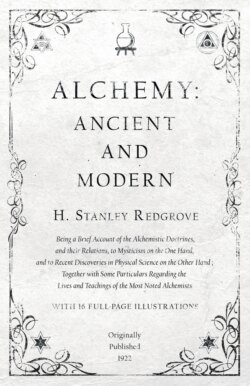Читать книгу Alchemy: Ancient and Modern - Being a Brief Account of the Alchemistic Doctrines, and their Relations, to Mysticism on the One Hand, and to Recent Discoveries in Physical Science on the Other Hand - H. Stanley Redgrove - Страница 21
Alchemy, Mysticism and Modern Science.
Оглавление§ 13. We notice the great difference between the alchemistic theory and the views regarding the constitution of matter which have dominated Chemistry since the time of Dalton. But at the present time Dalton’s theory of the chemical elements is undergoing a profound modification. We do not imply that Modern Science is going back to any such fantastic ideas as were held by the alchemists, but we are struck with the remarkable similarity between this alchemistic theory of a soul of all metals, a one primal element, and modern views regarding the ether of space. In its attempt to demonstrate the applicability of the fundamental principles of Mysticism to the things of the physical realm Alchemy apparently failed and ended its days in fraud. It appears, however, that this true aim of alchemistic art—particularly the demonstration of the validity of the theory that all the various forms of matter are produced by an evolutionary process from some one primal element or quintessence—is being realised by recent researches in the domain of physical and chemical science.
1 “EIRENÆUS PHILALETHES”: An Open Entrance to the Closed Palace of the King (see The Hermetic Museum, Restored and Enlarged, edited by A. E. Waite, 1893, vol. ii. p. 178).
2 PARACELSUS: “Concerning the Nature of Things” (see The Hermetic and Alchemical Writings of Paracelsus, edited by A. E. Waite, 1894, vol. i. p. 167).
3 The Sophic Hydrolith; or, Water Stone of the Wise (see The Hermetic Museum, vol. i. p. 74).
4 The Triumphal Chariot of Antimony (Mr. A. E. Waite’s translation, p. 13). See § 41.
5 ARTHUR EDWARD WAITE: The Occult Sciences (1891), p. 91.
6 F. B.: Lives of Alchemystical Philosophers (1815), Preface, p. 3.
7 ARTHUR EDWARD WAITE: Lives of Alchemystical Philosophers (1888), pp. 30, 31. As says another writer of the mystical school of thought: “If we look upon the subject [of Alchymy] from the point which affords the widest view, it may be said that Alchymy has two aspects: the simply material, and the religious. The dogma that Alchymy was only a form of chemistry is untenable by any one who has read the works of its chief professors. The doctrine that Alchymy was religion only, and that its chemical references were all blinds, is equally untenable in the face of history, which shows that many of its most noted professors were men who had made important discoveries in the domain of common chemistry, and were in no way notable as teachers either of ethics or religion” (“Sapere Aude,” The Science of Alchymy, Spiritual and Material (1893), pp. 3 and 4).
8 M. M. PATTISON MUIR, M.A.: The Story of Alchemy and the Beginnings of Chemistry (1902), pp. 105 and 106.
9 MICHAEL SENDIVOGIUS: The New Chemical Light, Pt. II., Concerning Sulphur (The Hermetic Museum, vol. ii. p. 138).
10 The Sophic Hydrolith; or, Water Stone of the Wise (see The Hermetic Museum, vol. i. p. 88).
11 Ibid. p. 114.
12 PETER BONUS: The New Pearl of Great Price (Mr. A. E. Waite’s translation, p. 275).
13 Which, in virtue of man’s self-consciousness, is, by the grace of God, immortal.
14 See the work Of Natural and Supernatural Things, attributed to “Basil Valentine,” for a description of the “spirits” of the metals in particular.
15 The Book of Lambspring translated by Nicholas Barnaud Delphinas (see the Hermetic Museum, vol. i. p. 277). This work contains many other fantastic alchemistic symbolical pictures, amongst the most curious series in alchemistic literature.
